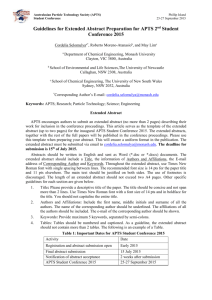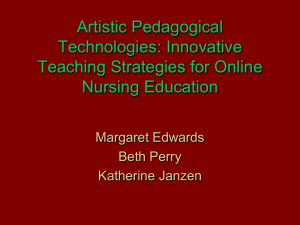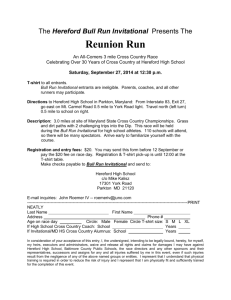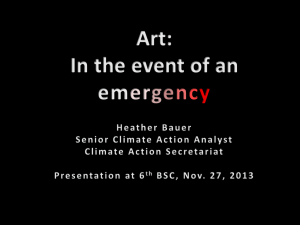Kelowna Paper-Invitational-Theory-Student_Data
advertisement
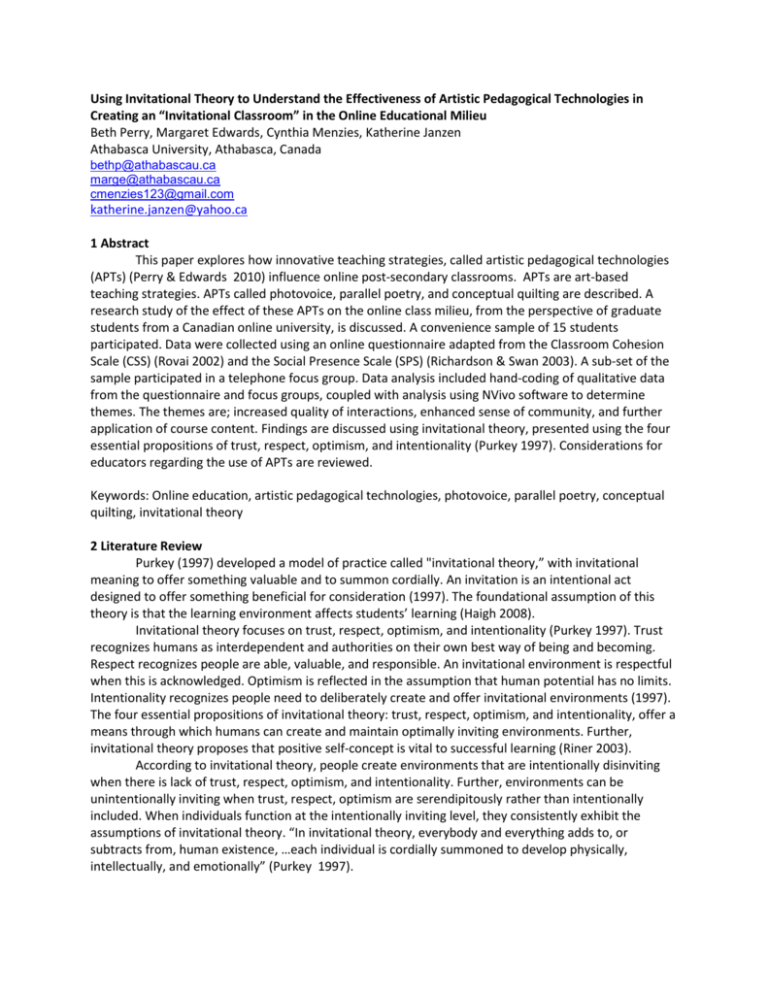
Using Invitational Theory to Understand the Effectiveness of Artistic Pedagogical Technologies in Creating an “Invitational Classroom” in the Online Educational Milieu Beth Perry, Margaret Edwards, Cynthia Menzies, Katherine Janzen Athabasca University, Athabasca, Canada bethp@athabascau.ca marge@athabascau.ca cmenzies123@gmail.com katherine.janzen@yahoo.ca 1 Abstract This paper explores how innovative teaching strategies, called artistic pedagogical technologies (APTs) (Perry & Edwards 2010) influence online post-secondary classrooms. APTs are art-based teaching strategies. APTs called photovoice, parallel poetry, and conceptual quilting are described. A research study of the effect of these APTs on the online class milieu, from the perspective of graduate students from a Canadian online university, is discussed. A convenience sample of 15 students participated. Data were collected using an online questionnaire adapted from the Classroom Cohesion Scale (CSS) (Rovai 2002) and the Social Presence Scale (SPS) (Richardson & Swan 2003). A sub-set of the sample participated in a telephone focus group. Data analysis included hand-coding of qualitative data from the questionnaire and focus groups, coupled with analysis using NVivo software to determine themes. The themes are; increased quality of interactions, enhanced sense of community, and further application of course content. Findings are discussed using invitational theory, presented using the four essential propositions of trust, respect, optimism, and intentionality (Purkey 1997). Considerations for educators regarding the use of APTs are reviewed. Keywords: Online education, artistic pedagogical technologies, photovoice, parallel poetry, conceptual quilting, invitational theory 2 Literature Review Purkey (1997) developed a model of practice called "invitational theory,” with invitational meaning to offer something valuable and to summon cordially. An invitation is an intentional act designed to offer something beneficial for consideration (1997). The foundational assumption of this theory is that the learning environment affects students’ learning (Haigh 2008). Invitational theory focuses on trust, respect, optimism, and intentionality (Purkey 1997). Trust recognizes humans as interdependent and authorities on their own best way of being and becoming. Respect recognizes people are able, valuable, and responsible. An invitational environment is respectful when this is acknowledged. Optimism is reflected in the assumption that human potential has no limits. Intentionality recognizes people need to deliberately create and offer invitational environments (1997). The four essential propositions of invitational theory: trust, respect, optimism, and intentionality, offer a means through which humans can create and maintain optimally inviting environments. Further, invitational theory proposes that positive self-concept is vital to successful learning (Riner 2003). According to invitational theory, people create environments that are intentionally disinviting when there is lack of trust, respect, optimism, and intentionality. Further, environments can be unintentionally inviting when trust, respect, optimism are serendipitously rather than intentionally included. When individuals function at the intentionally inviting level, they consistently exhibit the assumptions of invitational theory. “In invitational theory, everybody and everything adds to, or subtracts from, human existence, …each individual is cordially summoned to develop physically, intellectually, and emotionally” (Purkey 1997). Teachers who are intentionally inviting may create effective educational environments. According to Purkey (1997) this includes elements of respect such as treating learners as individuals, developing trust through honesty in interactions, behaving ethically, maintaining an optimistic perspective, sustaining energy and enthusiasm, and having high aspirations. Purkey concluded, invitational theory, “carries the basic message that human potential, while not always evident, is always there, waiting to be discovered and invited forth” (1997). Research demonstrates inviting educational environments have positive implications for learners. Cook (2005) found when clinical nursing faculty intentionally created an invitational milieu student anxiety decreased. Stanley, Juhnke, and Purkey, (2004) employed invitational theory, calling the result invitational education, to enhance school culture, improve academic achievement, and help stakeholders view concerns as symptoms rather than causes. Hunter and Smith (2007) applied invitational education to high school art classes and found an enhanced learning environment for students and teachers. Chant, Moes, and Ross (2009) found including the collaborative and inviting processes of invitational theory enhanced teacher creativity. Thompson (2004) concluded that employing the philosophy of invitational education created a more welcoming climate. Paxton (2003) advocates for the use of invitational theory principles in e-learning noting that elearning will only succeed if educators provide environments that preserve dignity and encourage communication. The converse, using an online environment to "throw information" at students has the opposite effect as it is experienced as deeply disinviting (2003, p. 923). Paxton identifies some of the more common disinviting practices currently experienced by learners who are new to the e-learning environment and examines practical ways in which online educators can make the environment more invitational (2003). This study furthers Paxton’s work demonstrating specific teaching strategies may aid online educators in creating educational environments that reflect Purkey’s principles of invitational theory. 3 A Description of Artistic Pedagogical Technologies APTs are a category of online teaching strategies founded in the arts (Perry & Edwards 2010). APTs use elements of drama, music, visual art, or the literary to help students learn. For example, APTs related to drama may use online role-playing and movie analysis. APTs that emphasize music can include a course theme song; while story-telling is a literary based APT. Photovoice, parallel poetry, and conceptual quilting are the APTs described in this paper. APTs are optional and non-graded. 3.1 Photovoice Photovoice was originally a participatory action research method (Wang 1999). Perry and Edwards adapted PV to become an APT and used it in online graduate courses (2006; 2010). PV uses visual art in the form of digital images. An image, thoughtfully chosen by the instructor, corresponds with a course theme. The image is combined with a reflective question and shared with online learners. Learners view the image and post their responses to the question in an online forum. An example of a PV activity used in a course on leadership is an image of a junior high basketball team sitting on a bench looking dejected. (figure 1) The reflective question reads, “As the leader, what would you say to inspire this team? What leadership style is reflected in your response?” The student responses to the image exhibit their knowledge of leadership literature and are rich with clues about their values, biases, personal history, and priorities in relation to leadership and followership. Figure 1: Example of a Photovoice Image 3.2 Parallel Poetry Parallel poetry has literary roots. It is organized as follows. The teacher writes a poem related to a course theme and presents this poem to learners. The teacher poem is both a model for students to follow, and contributes content related to a course topic. The poem can be of any form from ode to haiku. Students write a poem inspired by the instructor’s poem. Usually the student poem parallels the demonstration poem in format, and thus the name parallel poetry. Poems are potentially effective for capturing ideas and feelings that are difficult to communicate in writing (van Manen 1990). Parallel poetry provides an avenue for online learners to share their perspectives regarding complex or abstract course content in a succinct way. An example of this APT is included in figure 2. The teacher poem is about the concept of caring and the student parallel poem furthers the discussion of this theme. As with PV, parallel poems are often infused with information about participants’ values, priorities, and ways of thinking. Teacher Poem On Caring…. It is difficult To put into precise words, What it means to care. Is it giving, not taking? Is it listening, not talking? Is it bending, not standing strong? Student Poem On Caring… What does it mean to care? It is giving and taking, at just the right moments. It is listening and talking, in perfect balance. It is bending and standing strong, strong enough for two. Figure 2: Example of a Parallel Poem Couplet 3.3 Conceptual Quilting Conceptual quilting, often used as a summary activity, is an APT derived from the craft of quiltmaking. Learners are invited to create virtual quilts with words, ideas, metaphors and concepts from a course. Quilt-making requires learners to reflect on what they have learned, choosing important “take home” ideas and concepts. Students use PowerPoint to create these virtual quilts of concepts. When quilts are shared with the class, discussion arises about course concepts. The novelty of the array of quilts creates interest and excitement within the group. These results help solidify learning. Ifenthaler, Masduki and Seel (2011) found that concept maps help students put in place building blocks of knowledge that translate into meaningful learning and retention of instructional materials (p. 41). We propose that conceptual quilting may work in a similar way giving learners scaffolding on which to secure ideas and concepts from a course thus enhancing retention. An example of a conceptual quilt is provided in figure 3. Empathy and Caring Ethical Awareness And Mindfulness Critical Reflection Practice Interdisciplinary Collaboration Cultural Competence Education Context-Driven Curricula DIVERSITY of Learning Experiences Theory Structured Models of Reflection Gibbs Johns Multiple Approaches to Understanding Figure 3: Example of a Conceptual Quilt 4 Study Methods The authors completed a study of the effect of the APTs of PV, parallel poetry, and conceptual quilting on graduate students and instructors from a Canadian online university. The purpose of the research was to increase our understanding of how APTs influence the online post-secondary classroom. Ethical approval for the study was granted by the Research Ethics Board of the host university. This paper focuses specifically on data related to the students’ perspective. The instructors’ perspective is published elsewhere. 4.1 Sample The convenience sample included 15 students who had just completed an online graduate course in which the three APTs were used. The participants had completed one of three courses selected for the study. The three instructors teaching the courses were doctorally prepared, experienced, online educators. Since this was a qualitative study, the purpose of which is not to produce generalizable findings, a convenience sample, which is a non-random sample of accessible informative participants, is fitting. All students who completed the three courses in the study were contacted via email by the research assistant (RA) after all grades were finalized. The students did not know in advance that the courses they were taking were part of a study. The email from the RA invited them to contact her via email if they were interested in participating. The RA obtained informed consent from 15 students who responded. At the time of the study, one student had only completed one online course (the study course) and 14 participants had completed two or more online courses (including the study course). Participants were from across Canada and pursuing Master’s degrees in nursing or health studies online. 4.2 Data Collection All participants completed an online questionnaire that assessed their perspectives regarding the effect of APTs on the learning environment in the online post-secondary class they had just completed. The questionnaire was adapted from Rovai’s (2002) Classroom Cohesion Scale (CSS) and Richardson and Swan’s (2003) Social Presence Scale (SPS). The questionnaire, prepared using SurveyMonkey, collected qualitative and quantitative data. Completed questionnaires were sent electronically to the RA where they were coded and identifiers removed. Participants were asked if they were willing to participate in a follow-up focus group to provide data to augment the questionnaire responses. The focus groups were moderated by the RA and held using teleconferencing. The RA moderator initiated discussion by posing general questions and probed to gather data. Six of the original 15 respondents participated in the two, three member focus groups. Each group lasted 45 minutes. After each group the RA made written notes regarding key statements. 4.3 Data Analysis Data analysis included hand-coding of qualitative questionnaire and focus group data. The research team independently analyzed the data and then comparing findings. Specifically, texts were read several times; fragments of sentences or groups of sentences expressing a key idea were highlighted; and these were grouped to identify core themes. The discovery of themes was aided by using three points of reference; recurrence of ideas within the textual data; repetition; and forcefulness (Owen, 1984). Qualitative data were also analyzed using NVivo software. 4.4 Study Limitations The sample size was small. A convenience sample may have yielded bias findings. The findings are not intended to be generalized since this is a qualitative study. The findings do raise research questions for further investigation using quantitative methods. 5 Findings Analysis provided three themes, increased quality of interactions, enhanced sense of community, and furthered application of content. Each theme is presented enriched with verbatim participant quotes. 5.1 Increased Quality of Interactions Respondents reported that the quantity and quality of interactions among students were increased due to APTs. Students said APTs “freed” them to interact in a more informal way with others without “pressure to achieve.” One said, “folks could be themselves a little more instead of feeling like they had to be performing…. I got to see more of the other person as opposed to just seeing another scholar.” Another student noted that APTs encouraged meaningful interactions with classmates that in her opinion “wouldn’t be there at all without the APTs.” Respondents commented that the enhanced quality of interaction with classmates was at least in part attributed to the non-graded nature of APTs. As one said, “it was an accepting forum because there were no right or wrong answers and it was all about our own personal interpretations, it was very comfortable.” It was also important that the APTs were optional. One focus group participant said, “I may not have enjoyed it as much if it was mandatory.” Another said, “it was wise of the instructor to make these non-graded and optional.” The quality of interactions between students and instructors was also improved because of APTs. One said APTs provided evidence that the instructor “had been there,” meaning the instructor had logged into the course. Students commented that having the instructor add an APT such as a PV weekly to the course was tangible indication that she was an active member of the course community. This noticeable contribution seemed to be important to learners as, in their words, the instructor became more “real” to them, and they were more likely to have quality interactions with an instructor who “seemed authentic.” The APTs, in particular PV, was reported by students to contribute to the enhanced “personal online presence” of the instructor. This was reported to be a precursor to quality student-instructor interactions. Students said that through the photographic images selected and shared by their online teacher they “got to know” more about their teacher. The PV images chosen by the instructor reflected “some things about the teacher that you would likely not get to know without the activity, like what she liked and did for fun.” Respondents suggested that getting to know their teachers made them feel more comfortable asking questions about course content. One said, “I interacted more with the instructor in this course because I knew her better…she seemed approachable.” Another concluded, “this course, with the APTs, had better interaction than some in person classes I have taken.” Students contended increased quantity of interactions can enhance quality of interactions. A focus group participant explained it this way, “when classmates don’t log on frequently [to the online course] this affects quality of interactions and building of community.” In her opinion when instructors and students routinely and frequently log into the course opportunities for sustained meaningful dialogue result. APTs encouraged learners to log into the course often so they could see what “novel activity awaited them” and to check “if others had responded to their posts” regarding an APT. 5.2 Enhanced Sense of Community Most respondents said enhanced quality of interactions led to a sense of community in the online class. One singled out PV saying, “Photovoice allowed for more personal interactions and this resulted in a sense of intimacy and community.” Some noted that the community formed in the online class in part as a result of the students’ active engagement with APTs, which helped them to get to know others in the course. In doing so, the “class became a classroom setting.” Further this respondent added, “it was like we were really there together.” Another said that, “It was useful to have an outlet to get to know people and their perceptions of different things.” She said “knowing people is the first step in growing community.” APTs helped learners realize their classmates had “differing perspectives” as each person put a “different twist” on the interpretation of an image, design of a quilt, or penning of a poem. For example, one said, “APTs provided me the opportunity to reflect on other classmates’ comments and see multiple perspectives.” Another said APTs are “excellent vehicles for demonstrating different perspectives and helping us see in a real way that we all see things through different lenses.” Finally, a respondent said, “I learned that there are individual and different interpretations especially about the photos. I began to look forward to discovering how others saw the images. Instead of wanting everyone to see what I saw, I started to be interested in trying to also see their points of view.” This led her to conclude that PV activities were an “ah hah” experience that helped her understand, and value, differences in others. Embracing diversity enhances community. Development of online community is facilitated when participants form connections. The APTs helped respondents form foundational connections. In relation to PV one said, “we all saw something different in the image, yet in some sense many of us also saw similarities that bonded us.” Another noted that because of what individuals shared about PV images they were able to make connections. For example, in relation to an image of a school basketball team, several students shared that they were parenting junior high athletes. This commonality, realized through their PV responses, helped these students form alliances and discussion networks through the remainder of the course. As one student who was part of this parent group noted, “I found out through one PV that I had something in common with several in the class. I would not have discovered this without the PV activity. I got to know them and I was more likely to respond to their postings in other parts of the course.” One student commented that APTs gave the teacher an avenue for making connections with learners. She commented, “PV provided a forum for the professor to communicate with students in a meaningful way.” The connections made between students and the instructors were also important building blocks for class community. 5.3 Furthered Application of Content Students found APTs helped them “apply course content” to their personal and professional circumstances. They used APTs as a trigger to help them reflect on course concepts and then integrate these into what they already understood. One noted, “when I looked at the PV image and the question that came with it, I was pushed to start thinking about the course topic that was addressed in the question. One time the photo was of a leaf in fall and the question was about change management. It made me think about changes I was leading at work and it motivated me to do the course readings on change management.” APTs seemed to play a role in helping complex course topics become relevant and understandable. One respondent said, “APTs like PV and the quilt helped me to relate abstract thinking to a tangible/real object.” These learning activities seemed to help learners connect course topics to visual images helping them “make sense of difficult complex topics.” One commented that once she could connect key terms about a topic to something concrete like a picture, she could remember the terms and use them in the course. Another way that students noticed APTs aided them in applying content was in the way these activities “stimulated reflective thinking and sort of ’kick started’…free thought.” Similarly another said, “it does help to get ideas flowing.” Some attributed the motivating effect to the novelty of the activities. As one student said, “these activities captured my attention and in doing so stimulated my reflective and creative thinking processes.” Some suggested that using APTs to further application of course content was more appropriate for undergraduate rather than graduate courses. One student wrote that “APTs may be useful to stimulate non-competitive dialogue in first year courses because graduate students tend to be a bit intense no matter what the exercise.” The essence of this comment may be a caution to instructors using APTs in graduate courses that the goal of the exercise needs to be made clear for the activity to achieve the purpose of application of content. Respondents emphasized that it was important that instructors relate the APTs directly to the course content. Many were protective of their learning time and did not want to participate in learning activities that were not obviously focused on the course. They suggested that it was the instructor’s responsibility to convey to learners how the learning activity was valuable to their learning in the course. One said, “if the APT is not tied directly into what we are studying, if I don’t see the connection to what I am learning, I won’t see it as valuable.” 6 Discussion APTs may help create educational environments that students find invitational. Purkey’s (1997) invitational theory, especially the four propositions of trust, respect, optimism, and intentionality are useful in furthering discussion of the effect of APTs on the online educational milieu. Considerations for educators using APTs are provided. 6.1 Trust In Purkey’s model trust is founded in the recognition that people are interdependent and authorities on their own best way of being and becoming. APTs provide an avenue for learners to share what makes them unique. Through the ideas they include in conceptual quilts, responses to PV, and the content and tone of their parallel poems, students make public statements about their values, biases, priorities, and life circumstances. In other words, they get to know themselves better as they must engage in self-assessment in order to produce the APT responses, and they let others in the class get to know more about them. APTs provide people a vehicle to get to know each other through novel, noncompetitive, non-threatening activities. Potential is created for relationships to develop. As students come to recognize commonalities through what is shared during APTs, the possibility of interdependence arises. Learners move from being isolated individuals alone at computers, to members of a group who share common ideas, and respect and even admire divergent perspectives. Through interactions precipitated by APTs, a foundation of trust is formed that facilitates students and instructors working together for a greater purpose than simply achieving course objectives. APTs have no right answers. Students are acknowledged upfront as being the experts on their points of view. No point of view is held up by an authority figure (such as the instructor) as being superior. All interpretations are considered valuable to the individual and the group. Through participation in APTs learners gradually gain confidence that they are accepted in the group as the authority on their own best way of being and becoming. Trust is established as participants learn to accept each other and themselves. 6.2 Respect In Purkey’s model (2007) an environment is respectful when individuals are recognized as able, valuable, and responsible. APTs provide an avenue for this to occur. Students are not coerced into participating in APTs because they need to do so to earn marks. Rather learners are invited to participate. Some are willing to take a risk and contribute easily and early to the APT activities. Others take longer to become involved. In the three courses most students eventually did participate in the APT activities. This non-pressured environment demonstrates respect for learners, acknowledging each person is responsible for what, and how, they learn. When learners participate in APTs the instructor and other classmates usually respond in a positive way. Most likely because of the non-competitive nature of these activities, all members of the educational community enthusiastically acknowledge others’ contributions. The effort to participate is often applauded as ardently as the quality of the contribution. People get the sense from these responses that their work is valued. This effect of ongoing affirmation seems to cascade during the term as positive comments precipitate even more eager participation in upcoming APT activities. Interestingly, as the term proceeds the quality of the contributions improves and students become more able, and thus even more valued by their colleagues and teacher. The cycle continues and respect is a result. To Riner (2008) respect helps students foster a mutual relationship. 6.3 Optimism Optimism assumes that human potential has no limits (Purkey, 2007). Based on the student responses, the APTs help move student potential to greater heights. Students reported participating more in APTs than they originally thought they would. One commented “ I lurked in the forums watching what others did because I didn’t think I could do it.” This learner eventually responded to a PV activity, received encouraging responses from her classmates, and went on to participate in the quilting exercise as well. Perhaps optimism helped her overcome self-imposed doubts. Respondents emphasized the originality of APTs describing them as “creative,” “interesting,” and “different.” Such terms connote a sense of optimism and the attitude that success is possible even though APTs are challenging. The achievements generating optimism included learning more about the course content, forming meaningful relationships with classmates, and achieving enhanced selfconfidence as a graduate student. 6.4 Intentionality Invitational environments are intentionally created (Purkey 1997). Including APTs in online courses is can intentionally influence the milieu. When teachers offer activities that may be beneficial to individual learning, and valuable to the class as a whole, this in intentionality. The cordial attitude with which APTs are offered contributes in a positive way. The teacher is viewed by learners as caring about their learning and actively and tangibly participating in making the educational experience successful. An intentionally created positive learning environment affects the students’ ability to learn (Haigh 2008). 6.5 Considerations for Educators Using APTs APTs are easily adapted for use in various graduate and undergraduate courses, whether offered online or in person. The study findings offer guidance for educators who want to use APTs. First, respondents emphasized it is important that APTs are non-graded and optional. Students need to be invited in a genial way to participate, but they need to be left to choose to do so when they feel ready and are interested in becoming involved. The non-graded element removes the competitive potential and encourages classmates to respond in encouraging ways to contributions of others. Also inherent in the non-graded element is the assumption that no answers are valued over others. This is important to encourage participation, to help learners value divergent views, and to enhance development of self-worth and confidence in individuals. Second, study participants were clear in their direction to educators that APTs need to be relevant to course content. When developing a PV activity the image and accompanying reflective question need to be connected to the course topic. Images and questions must be thoughtfully selected and composed. Teachers using PV should have ideas in mind regarding how students may interpret the image and how it relates to the topic. Participants reminded us that they see no value participating in APTs that do not further their learning. Third, educators who use APTs should consider pros and cons of being active participants in the activities. On a positive note, active participation by teachers may help students become familiar with instructors and potentially more comfortable interacting with them on other course activities. Interactions and connections between students and teachers may be enhanced if teachers participate in APTs. This can have positive effects for students and provide fulfillment for teachers. Alternatively, when teachers actively participates in APTs students may consider the teachers’ responses the “right” answers even if it has been explained that there are no optimal responses. If teacher contributions are seen as model responses to PVs creativity and diversity in student contributions may be constrained. 7 Conclusion The online classroom environment is changed in positive ways in part because of the APTs. Research participants reported that APTs increased the quality of interactions, enhanced the sense of community, and furthered the application of course content. Purkey’s (1997) invitational theory; specifically the propositions of trust, respect, optimism, and intentionality, help explain these findings. Practical ideas for educators regarding the use of APTs were reviewed. 8 Acknowledgements Research funding – Social Sciences Research Council of Canada Photo – Otto F. Mahler Conceptual Quilt – Lori Whelan 9 References Chant, R., Moes, R., and Ross, M. (2009). Curriculum Construction and Teacher Empowerment: Supporting Invitational Education with a Creative Problem Solving. Journal of Invitational Theory and Practice, 15, pp. 55-67. Cook, L. (2005). Inviting teaching behaviors of clinical faculty and nursing students’ anxiety. Journal of Nursing Education, 44(4), pp.156-161. Haigh, M. (2008). Coloring in the emotional language of place. Journal of Invitational Theory and Practice, 14, pp. 25-40. Hunter, M., and Smith, K. (2007). Inviting school success: Invitational education and the art class. Journal of Invitational Theory and Practice, 13, pp.8-15. Ifenthaler, D., Masduki, I., and Seel, N. (2011).The mystery of cognitive structure and how we can detect it: tracking the development of cognitive structures over time. Instructional Science, 39(1), 41-61. Owen, W. (1984). Interpretative themes in relational communication. Quarterly Journal of Speech, 70, 274-287. Paxton, P. (2003). Inviting e-learning: How hard can it be? Journal of Invitational Theory and Practice, 9, pp. 923-940. Perry, B. (2006). Using photographic images as an interactive online teaching strategy. The Internet and Higher Education, 9(3), pp. 229-240. Perry, B., and Edwards, M. (2010). Interactive teaching technologies that facilitate the development of online learning communities in nursing and health studies. Teacher Education Quarterly, Special Online Edition. Retrieved from http://teqjournal.org/perry_edwards.html Purkey, W.W. (1992). An introduction to invitational theory. Journal of Invitational Theory and Practice, 1, pp. 5-15. Purkey, W. W. (2007). An introduction to invitational theory. Retrieved from www.invitationaleducation. net/ie/ie_intro2.htm. Richardson, J. and Swan, K.(2003). Examining social presence in online courses in relation to students’ perceived learning and satisfaction. Journal of Asynchronous Learning Networks, 7(1), pp. 68-88. Riner, P. (2003). The intimate correlation of invitational education and effective classroom management. Journal of Invitational Theory and Practice, 9, pp. 41-55. Riner, P. (2008). Blue, orange, white, and brown: Causality, values, and the impact of messages. Journal of Invitational Theory & Practice,14, pp.3-10. Rovai, A. P. (2002). Development of an instrument to measure classroom community. Internet and Higher Education, 5(3), pp.197-211. Stanley, P.H., Juhnke, G., and Purkey, W.W. (2004). Using an invitational theory of practice to create safe and successful schools. Journal of Counseling and Development, 82(3), pp.302-310. Thompson, D.R. (2004). Organizational learning in action: Becoming an inviting school. Journal of invitational theory and practice, 10,pp. 52-72. Wang, C. C. (1999). Photovoice: A participatory action research strategy applied to women’s health. Journal of Women’s Health, 8(2), pp.185-192. van Manen, M. (1990). Researching lived experience: Human science for an action sensitive pedagogy. London, ON: Althouse.
